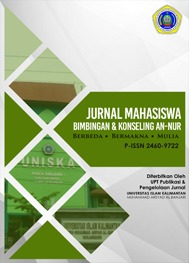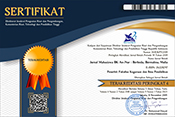ADAPTASI DAN VALIDASI INSTRUMEN REVISED CYBER BULLYING INVENTORY II (RCBI II) BAGI PESERTA DIDIK SEKOLAH MENEGAH ATAS DI INDONESIA
(1) Universitas Negeri Jakarta
(2) Universitas Negeri Jakarta
(3) Universitas Negeri Jakarta
(*) Corresponding Author
Sari
This study aims to adapt and validate the Indonesian version of the Revised Cyber Bullying Inventory II (RCBI II) instrument for high school students in Indonesia. Researchers conducted a confirmatory analysis (CFA) and found out the adaptation scale of Revised Cyber Bullying Inventory II (RCBI II) that can be applied in Indonesia. This study uses a quantitative method of psychometric properties. The research sample was 200 high school students in Indonesia. Data analysis used Confirmatory Factor Analysis (CFA) in the Linear Structural Relationship (Lisrel) program. Based on the Goodness of Fit Statistics, the model fit was obtained with the values: RMSEA: 0.045; ECVI: 1.67; NFIs: 0.87; CFI: 0.94; RFI: 0.83; GFI: 0.91; AGFI: 0.87. The conclusion from the research results is that the Indonesian version of the Revised Cyber Bullying Inventory II (RCBI II) instrument is suitable for use by students in high schools in Indonesia.
Kata Kunci
Teks Lengkap:
PDFReferensi
Akbulut, Yusuf & Bahadir (2010). Development of Scale to Investigate Cybervictimization among Online Social Utility Members. Contemporary Education Technology.
Afiyani, I., Cicih, W. dan Dhi, B. (2019). Identifikasi Ciri-Ciri Perilaku Bullying dan Solusi untuk mengatasinya di Sekolah. Jurnal Mahasiswa BK An-Nur.
Alvarez, D., et al. (2015). Validation of the Cybervictimization Questionnaire (CYVIC) for Adolescent. Computer in Human Behavior.doi.org/10.1016/j.chb.2017.01.007
Barlett, C., Douglas, A., & Chelsea, C. (2016). Predicting Cyberbullying From Anonymity. Psychological Association. doi.org/10.1037/ppm0000055
Barlett, C.., Kristina, C., Zachary, W. (2017). Predicting Cyberbullying Perpetration in Emerging Adults : A Theretical Test of the Barlett Gentile Cyberbullying Model. Aggressive Behaviour. doi.org/10.1002/ab.21670
Barlett, C., et al., (2018). Social Media Use as a Tool to Facilitate or Reduce Cyberbullying Perpetration : A Review Focusing on Anonymous and Nonanonymous Social Media Platform. Violence And Gender. doi: 10.1089/vio.2017.0057
Bauman, S., & Newman, M. (2013). Testing assumptions about cyberbullying: Perceived Distress Associated with Acts of Conventional and Cyber Bullying. Psychology of Violence. doi: 10.1037/a0029867
Buelga, S., Belen, M,, & Maria-J. (2017). Differences in Family Climate and Family Communication among Cyberbullies, Cybervictims, and Cyber Bully Victims. Computer in Human Behaviour. doi: 10.1016/j.chb.2017.07.017
Butt, S., Farhat, J., Ruhi, K. (2019). Cyberbullying, Self-Esteem and Interpersonal Trust in Young Adults. Pakistan Journal of Social and Clinical Psychology.
Deenamjued, R., & Waiphot K. (2017). Antecendents of Cyber Bullying Behaviors of High School Students: A Case Study of Facebook. Conference of the International Journal of Arts & Sciences. doi: 10(02):295–304
Fernandez, C., Felix, E.. & Rosario, O. (2015). Explicative Factors of Face-to-Face Harassment and Cyberbullying in a Sample pf Primary Students. Psicothema. doi:
7334/psicothema2015.35
Festl, R., et al. (2017). Longitudinal Patterns of Involvement in Cyberbullying: Results from a Latent Transiton Analysis. Computer In Human Behavior.doi: 10.1016/j.chb2016.09.027
Fluck, J. (2018). Investigating the Comparability of Two Multi-Item-Scales for Cyber Bullying Measurement. International Journal of Environmental Research and Public Health. doi:10.3390/ijerph15112356
Gencdogan, B. & Ozkan, C. (2015). Reliability And Validity Studies Of The Turkish Version of The e-Bullying Scale (e-BS) and e-Victimization Scale (e-VS). Journal of Theory and Practise in Education.
Hellfeldt, K., et al. (2019). Cyberbullying and Psychological Well-being in Young Adolescence: The Protective Mediation Effects of Social Support from Family, Friends, and Teachers. International Journal of Environmental Research and Public Health. doi.org/10.3390/ijerph17010045
Hidajat, M., et al., (2015). Dampak Media Sosial dalam Cyber Bullying. Journal Comtech: Computer, Mathematics and Engineering Aplications. doi:10.21512/comtech.v6i1.2289
Hinduja, S. & Justin, W. (2017). Cultivating Youth Resilience to Pevent Bullying and Cyberbullying Victimazation. Child Abuse & Neglect.doi: 10.1016/j.chiabu.2017.09.010
Iranzo, B., et al., (2019). Cyberbullying, Psychosocial Adjustment, and Suicidal Ideation in Adolescence. Psychosocial Intervention. doi.org./10/5093/pi2019a5
Li, J., et al., (2019). Incidence, Risk Factors and Psychosomatic Symptoms for Traditional Bullying and Cyberbullying in Chinese Adolescents. Children and Youth Services Review. doi: 10.1016/j.childyouth.2019.10451
Listiyani, L., Astuti, W., dan Flora, G. (2020). Mengatasi Perilaku Cyberbullying pada Remaja. Prosiding Seminar Nasional Pengabdian pada Masyarakat.
Lucas, M., et al., (2021). Bullying, Cyberbullying and Mental Health: The Role of Student Connectedness as a School Protective Factor. Psychosocial Intervention.
Makri, E & G, Karagianni. (2014). Cyberbullying in Greek Adolescents: The Role of Parents Procedia: Social and Behavioral Sciences. doi: 10.1016/j.sbspro.2014.01.742
Martinez, J., Antonio, J., & Izabela, Z. (2020). Bullying and Cyberbullying in Adolescent from Disadvantaged Areas: Validation of Questionnaires; Prevalence Rates; and Relationship to Self-Esstem, Empathy and Social Skills. International Journal of Environmental Research and Public Health. doi.10.3390/ijerph17176199
Mawardah, C., et al., (2018). The Factors of Cyber Bullying and the Effects on Cyber, Victims. International Journal of Research and Innovation in Social Science (IJRISS).
Nasywa, N., Fatwa, T. & Mujidin. (2020). Testing the Validity and Reliability of the Cyber . American Research Journal of Humanities Social Sciences (ARJHSS).
Notice, A. H. (2018). Bullying in England April 2013 to March 2018. London: Departement for Education.Ahmad, H. (2022). Hubungan Kestabilan Emosi Dengan Kontrol Diri Siswa Sekolah Menegah Pertama. Realita: Jurnal Bimbingan Dan Konseling, 6(2).
Ozgur, H. (2015). Exploring The Distance Education Students Cyberbullying, Cyber . Turkish Online Journal of Distance Education. doi: 10.17718/tojde.07460
Phizacklea, T. & Rebecca, J. (2018). The Cyberbullying Experiences Survey with New Zealand Psychology Students. International Journal of Psychology & Behavior Analysis. doi: 10.15344/2455-3867/2018/146
Qodir, A., Ahmad, M. & Triantoro, S. (2019). Cyberbullying, Happiness, And Style of Humor Among Perpetrators is There a Relationship? Humanities & Social Sciences Reviews. doi.org/10.18510/hssr.2019.7331
Setiawan, F. (2018). Dampak Perilaku Bullying Terhadap Kehidupan Sosial Siswa Sekolah Dasar di Kecamatan Driorejo Kabupaten Gresik. Jurnal Inventa. 11, (1), 87-92.
Shaikh, F., Mobashar, R. & Aamir, A. (2020). Cyberbullying: A Systematic Literature Review to Identify the Factors Impelling University Students Towards Cyberbullying. IEEE Xplore. doi: 10.1109/ACCESS.2020.3015669
Smith, P., et al., (2006). An Investigation Into Cyebrbullying, Its Forms, Awareness and Impact, and The Relationship Between Age and gender In Cyberbullying. Research Brief .
Suslu, D. (2018). A Study on Self-Esteem, Mother, Father, and Peer Relations as Predictors of Cyberbullying and Cyber-victimization in High School Students. Journal of Human Sciences.
Taufiq, A., & Herdi, H. (2020). New Group Counseling Competencies Scale-Short Form to Supervise Group Counselor Candidates. Jurnal Kajian Bimbingan dan Konseling. doi: 10.17977/um001v5i22020p055
Topcu, C. & Ozgur, E. (2010). The Revised Cyber Bullying Inventory (RCBI) : Validity . Procedia Social and Behavioral Sciences. doi: 10.1016/j.sbspro.20
07.161
Topcu, C. & Ozgur, E. (2017). RCBI II: The Second Revised Cyber Bullying Inventory. Measurement and Evaluation in Counseling and Development. doi: 10.1080/07481756.2017.1395705
Triantoro, S. (2016). Prevalence and Impact of Cyberbullying in a Sample of Indonesian Junior High School Students. . Turkish Online Journal of Educational Technology – TOJET.
Utami, Y. (2014). Cyberbullying di Kalangan Remaja (Studi tentang Korban Cyberbullying di Kalangan Remaja di Surabaya). Journal Universitas Airlangga.
Uusitalo, L & Juhani, E. (2016). Happiness and depression in the traditionally bullied and cyberbullied 12-year-old. Open Review of Educational Research.
Wani, M., R. Sankar. & Anichman, J. (2017). Assesment of Cyber Bullying and Emotional Stabiliy Among Higher Secondary Students. Journal of Scientific & Technological Research: Bio Medical. doi:10.26717/BJSTR.2017.01.000147
Wolke, D., Kirsty, L. & Alexa, G. (2017). Cyberbullying: a Storm in a Teacup?. European Child & Adolescent Psychiatry.
Yubero, S., et al., (2017). Cyberbullying Victimization in Higher Education: An Exploratory Analysis of Its Association with Social and Emotional Factors among Spanish Students. Computers in Human Behavior. doi: 10.1016/j.chb.2017.05.037
Yunanto, T. (2018). Perlukah Kesehatan Mental remaja? Menyelisik Peranan Regulasi Emosi dan Dukungan Sosial Teman Sebaya dalam Diri Remaja. Jurnal Ilmu Perilaku. doi:
25077/jip.2.2.75-88.2018
Zhang, X., Ziqiang, H., & Zhanlong, B. (2020). Cyberbullying Involvement and Psychological Distress among Chinese Adolescents: The Moderating Effects of Family Cohesion and School Cohesion. International Journal Environmental Research and Public Health. doi:
3390/ijerph17238938
Zych, I., Rosario, O., & Rosario, D. (2015). Sytematic Review of Theoretical Studies on Bullying and Cyberbullying: Where have we been and where are we going. Aggression and Violet Behavior. doi: 10.1016/j.avb.2015.05.015
DOI: http://dx.doi.org/10.31602/jmbkan.v9i1.10288
Refbacks
- Saat ini tidak ada refbacks.
Akun Akademik Anda Terhubung dengan :
Didedikasikan Untuk:
Jurnal Mahasiswa BK An-Nur : Berbeda, Bermakna, Mulia disseminated below Lisensi Creative Commons Atribusi 4.0 Internasional.
















